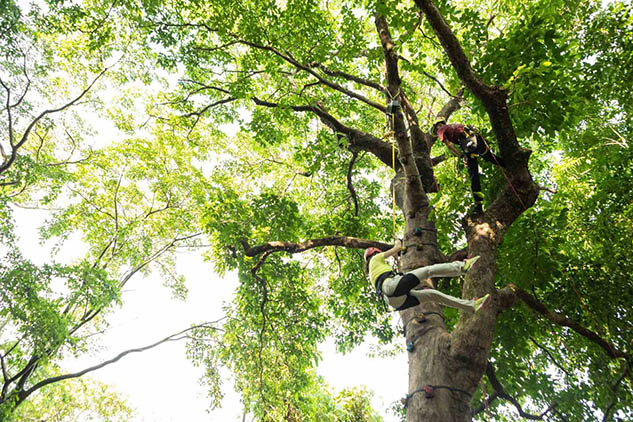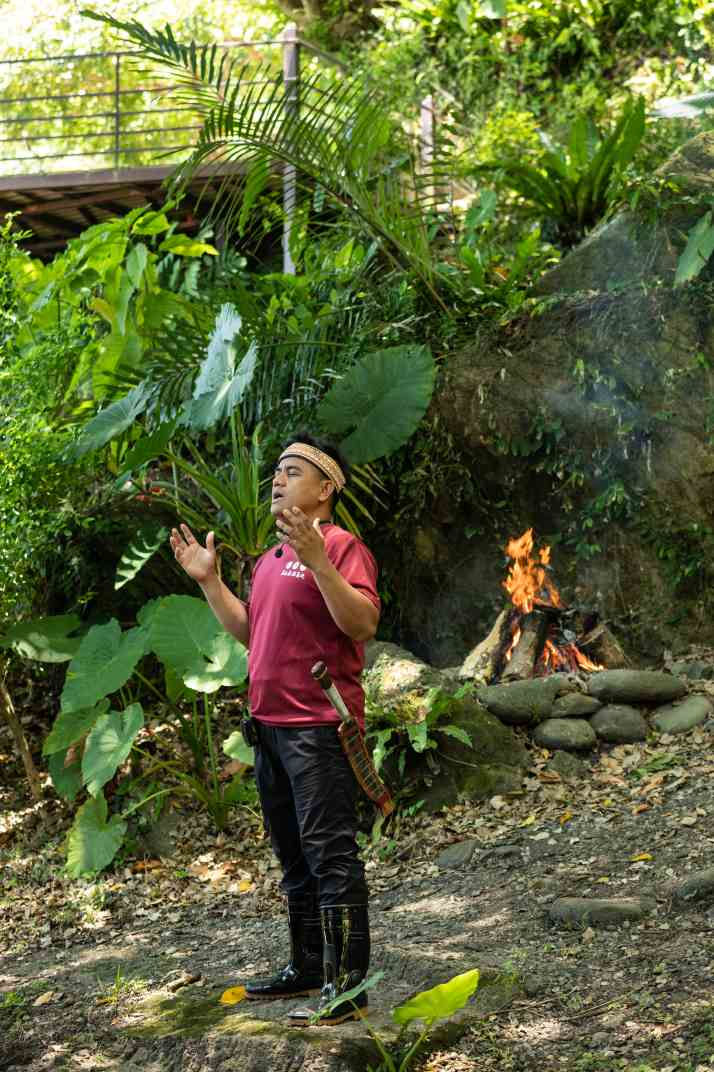A Bunun Tribe in Hualien Elevates Indigenous Culture for the Right Travelers

Source:Zhouqi Wu
Not content for the indigenous experience to be a superficial whirlwind, this Bunun Tribe settlement in Hualian’s Fengbin Township opted for an immersive experience instead of pandering to the mass market, attracting indigenous visitors from as far afield as Maori from New Zealand.
Views
A Bunun Tribe in Hualien Elevates Indigenous Culture for the Right Travelers
By Meng-hsuan YangFrom CommonWealth Magazine (vol. 701 )
Following Route 11 to Fengbin Township in Hualian County, the expansive Pacific Ocean stretches out to the horizon on one side. On the opposite side, on a bluff 150 meters above sea level, stands the Gao Shan Forest Center. Despite the name, which means “high mountains” in Chinese, Gao Shan is not a high mountain, but rather the name of a settlement of the indigenous Bunun tribe.
Following a steady wood-knocking sound, we come to the visitors’ welcome plaza, where two towering trees and a small semi-circular rock cave contribute to a primal appearance.
Visitors tread on historical ground
Tiang Ma, co-founder of the Gao Shan Forest Center, greets the guests wearing a knife at his waist and a traditional Bunun headdress. He fires a hunting rifle and chants an ancient Bunun melody, his resounding voice reverberating through the forest. Next, he recounts the Gao Shan settlement’s history. At this moment , visitors are encouraged to trade in their identities for the moment to become hunters.
The welcoming ceremony Tiang Ma presides over is meticulously designed to elevate the level of native community tourism. “The tribal settlement is a nation, with a distinctive cultural milieu, sacrifices, ethics and politics handed down over the generations. I hope tourists can take it all in with their cultural vision in an environment of mutual respect.”
The land that visitors walk upon is living history, and the story’s protagonist is Tiang Ma’s paternal grandfather.
Gao Shan happens to be the only coastal Bunun Tribe settlement in Taiwan. During the Japanese period (1895-1945), the Japanese government used a combination of intimidation and coercion, while the subsequent Nationalist government encircled Taiwan’s highlands, forcing Tiang Ma’s grandfather to move his family four times over the years, eventually relocating from Nantou to Hualian.
The current location of the base is where tribal members settled down after the third displacement. “It doesn’t have the best scenery here, but it’s got the most history,” says Ma.
The “eco restroom” was made upon the earthen walls of a corral once used for keeping Formosan sambar deer. A large rock three meters tall along the ancient hunting trail is where Ma’s grandfather would amble up and gaze upon the distant mountains and sea in his later years.
Cultural atmosphere and historical stories can immerse tourists at the base, as opposed to just touring. For instance, the hunting experience is more than a basic archery class. “We stress the combination of wisdom and hunting skills, to keep hunting and shooting mountain boars from becoming a tacky activity,” explains Ma.
Staff members guide tourists to the hillside slopes behind the base. Placing knotted silvergrass at the forest entrance is a customary Bunun warning that hunters are prowling within the woods beyond.
Prior to commencing the archery activities, an overview of hunting etiquette is given: Prey that can be seen, targeted, but not accessed should not be taken so as to prevent waste; immature animals should not be shot; animals with young should not be shot. Only mature animals can be considered proper game.
Accordingly, the four woven wicker mountain boars before the visitors fit the criteria for proper hunting targets.
Here, visitors are not taught how to aim, but how to feel their bodies become one with the bow and arrow, count paces, and draw the bow to shoot in a three-second sequence. And with a whoosh, to hit the bullseye.
To simulate night-time hunting conditions in the woods, he has the visitors close their eyes, place their hand on the shoulder of the partner in front of them, and carefully step forward. This awakens one’s hearing and touch, heightening perception and tension, and attuning perception to every little variation in the forest.

Elevate product value, attracting the right demographics
Tiang Ma believes that today’s native tourism should consider how to progress from points to lines, or to further represent traditional indigenous cultural values and make casting nets, archery, pounding mochi, and singing and dancing more meaningful.
The system behind the techniques comes from generations of indigenous people and their connections to the forests, sea, and creeks and rivers. And these make for the most meaningful type of content.
Early on in the operation, travel agencies came around to negotiate prices, compressing rates to between NT$500 and $800. However, Tiang Ma found that there was no way to ensure quality or run activities with any sort of depth at such low rates. “The look in the tourists’ eyes was empty, and the center became a superficial site for photo ops. We felt that we shouldn’t be delivering that sort of experience.”
So he raised the rates to over NT$1,000 per person, which allowed more screening of visitors. He even enlisted members of a performance troupe to provide guidance on how to offer an immersive sensory experience, and help strip away extraneous aspects. One feature that the troupe suggested adding was drumming during the welcome ceremony.
“Looking to just make money and pandering to the market will lead to the collapse of even the most distinctive site. We decided to offer an excellent product to attract the right clientele.” Ma seeks to renew the community’s distinction through experiences of the forest and culture, and to foster spiritual growth through the coming together and clashing of various cultures.
The concept of a high mountain forest base has attracted visits from minorities around the world including the Maori people of New Zealand, diplomats from Palau, and Sherpa from Nepal.
Tour guide Hugo Peng, who specializes in high-end tours in Europe, observes that immersive experiences are the trend of the future. Especially under the current pandemic conditions preventing high-end tourists from heading abroad, clientele that are drawn to nature, culture, in-depth cultural experiences, and eco-tourism could be very interested in the Gao Shan mountain forest settlement.
“Ma understands the meaning of every rock, every tree, and mountain in the community, and can interpret the current state and historical context of the Gao Shan Bunun tribe and indigenous peoples, and tie all sorts of stories together as a whole. And that’s incredibly moving,” remarks Peng.
The Gao Shan Forest Center offers customized itineraries by reservation only. Prior to the pandemic, it was welcoming an average of three tour groups per week. Since the pandemic, it has had daily bookings, most of which are from travelers focused on tour quality.
Successfully turning around the public’s image of indigenous tourism is the result of Tiang Ma’s decade-long commitment. Fengbin’s ethnic diversity is wide-ranging, spanning the Amis, Sakizaya, Kamalan, and Bunun tribes, along with ethnic Chinese Hakka and Minnan villages. Among this company, the Bunun are the smallest and most disadvantaged group.
Bonding with nature, adventurous spirit
A career soldier, 10 years ago Tiang Ma returned to the community to find it beset by the same poverty and lack of development as before. This set the wheels of his mind in motion, thinking about how to do something for the tribe. While home on leave and holidays, he conducted field studies, interviewing tribal elders to learn all about the Gao Shan settlement’s history of relocation and its customs. After retiring from the military three years ago, he compiled the results of his surveys and interviews into content, and designed in-depth experiences.
Around this time, Jasper Hsu, a clinical psychologist and passionate outdoorsman, spotted several old trees on the base that looked eminently suitable for climbing, making them perfect props for the “adventure therapy” he studies and practices. This led to him joining the base as a co-founder, and setting up an adventure experience curriculum.
Tree-climbing activities incorporate indigenous cultural elements and traditional folk songs. “Back in the day, the tribal hunters would climb atop a centuries-old red fruit fig tree and look for eggs in an eagle’s nest. Adventure has always been part of indigenous culture. And now we can help visitors cultivate courage and their adventurous spirit, and bond with nature,” adds Hsu.
Partners from different ethnic backgrounds contribute their strengths and share their cultures, forming a unique combination in Taiwan’s indigenous travel field. “My understanding of indigenous communities is deep, but not broad enough. Including my partners’ perspectives helps forge a unique indigenous experience,” offers Ma.
Have you read?
♦ Taiwan’s Domestic Tourism Challenge: Going High End
♦ Indigenous Culture, not Food, is Taiwan’s Top Tourist Attraction
♦ Can Taiwan Become A Tourism Powerhouse?
Best of Taiwan
♦ Discover the Danlan Old Trails: Taiwan’s Pilgrimage of Nature
♦ The Best Hiking Trails in Taiwan
♦ Best Travel Spots for #Taiwanders
Translated by David Toman
Edited by TC Lin
Uploaded by Judy Lu






